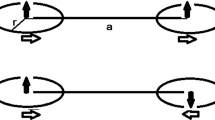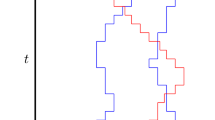Abstract
This paper discusses an outstanding issue in philosophy of physics concerning the relation between quantum symmetries and the notion of physical equivalence. Specifically, it deals with a dilemma arising for quantum symmetry breaking that was posed by Baker (Philos Sci 78:128–148, 2011), who claimed that if two ground states are connected by a symmetry, even when it is broken, they must be physically equivalent. However, I argue that the dilemma is just apparent. In fact, I object to Baker’s conclusion by showing that the two thermodynamical phases of a ferromagnet, which are connected by the so-called flip-flop symmetry, are physically inequivalent, thereby providing a counter-example to his claim.
Similar content being viewed by others
Notes
More in general, one can describe a physical system by means of a C*-algebra, namely an algebra of observables equipped with an involution and a norm, which is closed under the uniform topology. Von Neumann algebras are a special case of C*-algebras, which are just closed under the weak operator topology. Equivalently, a von Neumann algebra coincides with its double commutant. Unless otherwise specified, throughout the paper it is assumed that the algebras of observables we deal with are all von Neumann algebras, for which the results we discuss here hold true.
Note that for the kind of GNS representations we consider in the remainder of the paper the underlying Hilbert space turn out to be separable.
In the special case of inner automorphisms, one can even show that if \(\omega \) is a pure state on \({\mathcal {A}}\) then one obtains \(\bar{U} = \pi (U)\) for the unitary operator acting across the representations.
See Baker and Halvorson (2013) for a proof of this fact, which they refer to as the Specialized Representation Wigner Theorem.
Indeed, for any \(A \in {\mathcal {A}}\) the action of \(W_{\pm }\) is such that the element \(\pi _{+}(A)\) belonging to \(\pi _{+}({\mathcal {A}}) \subseteq {\mathcal {B}}({\mathcal {H}}_{+})\) is transformed into an element \(W_{\pm }^{*}\pi _{+}(A)W_{\pm }\) belonging to \(\pi _{-}({\mathcal {A}}) \subseteq {\mathcal {B}}({\mathcal {H}}_{-})\), but the resulting operator is not equal to \(\pi _{-}(A)\). Else, if it were equal, given that \(\Omega _{-} =W_{\pm } \Omega _{+}\), the state \(\omega _{+}(A) =\langle \Omega _{+}, \pi _{+}(A) \Omega _{+} \rangle \) would become
$$\begin{aligned} \langle W_{\pm } \Omega _{-}, \pi _{+}(A)W_{\pm } \Omega _{-} \rangle = \langle \Omega _{-}, W_{\pm }^{*}\pi _{+}(A)W_{\pm } \Omega _{-} \rangle = \langle \Omega _{-}, \pi _{-}(A) \Omega _{-} \rangle \end{aligned}$$for all A in the quasi-local algebra \({\mathcal {A}}\), which is exactly the state \(\omega _{-}(A)\): consequently, the two phases \(\omega _{+}\) and \(\omega _{-} = \bar{\alpha }_{\pm } (\omega _{+})\) of the infinite spins chain would coincide, notwithstanding the fact that they are connected by the broken symmetry \(\alpha _{\pm }\). Instead, by appealing to the Wigner representation theorem we can infer that, rather than being equal to \(W_{\pm }^{*}\pi _{+}(A)W_{\pm }\), the operator \(\pi _{-}(A)\) is equal to \(W_{\pm }^{*}\pi _{+}(\alpha _{\pm }(A))W_{\pm }\) for all \(A \in {\mathcal {A}}\).
In this respect, it should be mentioned that Feintzeig (2015) argues that some of the features that Baker finds puzzling in quantum symmetry breaking are present in examples of classical broken symmetries too.
In algebraic terms the transition probability between two states \(\omega \) and \(\omega '\) is expressed by formula \(1 -\frac{1}{4} \Vert \omega - \omega ' \Vert ^{2}\), where \(\Vert \cdot \Vert \) is the norm on the state space \({\mathcal {S}}({\mathcal {A}})\) (cfr. Roberts and Roepstorff 1969).
As I stressed at the beginning of section 5, Feintzeig (2015) makes a similar point for the classical spin chain.
Note that, strictly speaking, the pure states \(\omega _{+}\) and \(\omega _{-}\) should be written in such a way to display their dependence on 0 and \(\beta \), like the mixed states of which they are the components. However, in order for not to overburden the notation, for simplicity here I drop the subscripts relative to the external magnetic field and the inverse temperature, just as I have done in the rest of the paper.
An extended discussion about the difference between the treatment of symmetry breaking between quantum statistical mechanics and quantum field theory can be found in Fraser (2012).
References
Arageorgis, A. (1995). Fields, particles and curvature. Unpublished dissertation, University of Pittsburgh.
Baker, D. (2011). Broken symmetry and spacetime. Philosophy of Science, 78, 128–148.
Baker, D., & Halvorson, H. (2013). How is spontaneous symmetry breaking possible? Understanding Wigner’s theorem in light of unitary inequivalence. Studies in History and Philosophy of Modern Physics, 44(4), 464–469.
Bargmann, V. (1964). Note on Wigner’s theorem on symmetry operations. Journal of Mathematical Physics, 5, 862–868.
Earman, J. (2003). Rough guide to spontaneous symmetry breaking. In K. Brading & E. Castellani (Eds.), Symmetries in physics: Philosophical reflections (pp. 335–346). Cambridge: Cambridge University Press.
Emch, G. G. (2007). Quantum statistical physics. In J. Butterfield & J. Earman (Eds.), Philosophy of physics (pp. 1075–1182). New York: Elsevier.
Emch, G. G., & Knops, H. J. F. (1970). Pure thermodynamical phases as extremal KMS states. Journal of Mathematical Physics, 11, 3008–3018.
Feintzeig, B. (2015). On broken symmetries and classical systems. Studies in the History and Philosophy of Modern Physics, 52B, 267–273.
Fraser, D. (2012). Spontaneous Symmetry breaking: Quantum statistical mechanics versus quantum field theory. Philosophy of Science, 79(5), 905–916.
Glimm, J. M., & Kadison, R. V. (1960). Unitary Operators in C*-algebras. Pacific Journal of Mathematics, 10, 547–556.
Haag, R. (1996). Local quantum physics: Fields, particles, algebras. Berlin: Springer.
Halvorson, H., & Clifton, R. (2001). Are rindler quanta real? Inequivalent particle concepts in quantum field theory. British Journal for the Philosophy of Science, 52, 417–470.
Hoefer, C. (1996). The metaphysics of spacetime substantivalism. Journal of Philosophy, 93, 5–27.
Liu, C., & Emch, G. G. (2005). Explaining quantum spontaneous symmetry breaking. Studies in History and Philosophy of Modern Physics, 36, 137–163.
Roberts, J. E., & Roepstorff, G. (1969). Some basic concepts of algebraic quantum theory. Communications in Mathematical Physics, 11, 321–338.
Ruetsche, L. (2002). Interpreting quantum field theory. Philosophy of Science, 69, 348–378.
Ruetsche, L. (2003). A matter of degree: Putting unitary inequivalence to work. Philosophy of Science, 70(5), 1329–1342.
Ruetsche, L. (2006). Johnny’s so long at the ferromagnet. Philosophy of Science (Proceedings), 73, 473–486.
Ruetsche, L. (2011). Interpreting Quantum Theories. New York: Oxford University Press.
Ruetsche, L. (2013). Unitary equivalence and physical equivalence in the Oxford handbook of philosophy of physics. New York: Oxford University Press. ed. Bat- terman R.
Teller, P. (1991). Substance, relations and arguments about the nature of space-time. Philosophical Review, 100, 363–97.
Wigner, E. P. (1931). Gruppentheorie und ihre Anwendung auf die Quanten mechanik der Atomspektren (in German) (pp. 251–254). Braunschweig, Germany: Friedrich Vieweg und Sohn.
Acknowledgements
The author is especially grateful to Dave Baker, Erik Curiel, John Earman and Ben Feintzeig for helpful comments and discussions. He would also like to thank the FWF der Wissenschaftsfonds for supporting him under the Lise Meitner Programme during the development of this project.
Author information
Authors and Affiliations
Corresponding author
Additional information
Publisher's Note
Springer Nature remains neutral with regard to jurisdictional claims in published maps and institutional affiliations.
Rights and permissions
About this article
Cite this article
Valente, G. Quantum symmetry breaking and physical inequivalence: the case of ferromagnetism. Synthese 198, 8127–8148 (2021). https://doi.org/10.1007/s11229-020-02561-y
Received:
Accepted:
Published:
Issue Date:
DOI: https://doi.org/10.1007/s11229-020-02561-y




